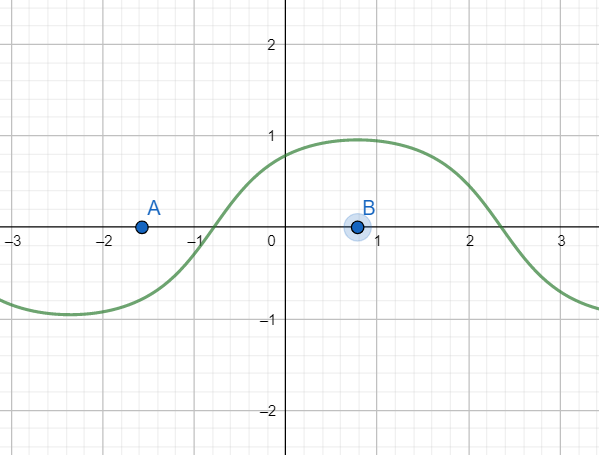
The function arctan(sinx + cosx) is increasing in the interval
[a] $\left( \dfrac{\pi }{4},\dfrac{\pi }{2} \right)$
[b] $\left( -\dfrac{\pi }{2},\dfrac{\pi }{4} \right)$
[c] $\left( 0,\dfrac{\pi }{2} \right)$
[d] $\left( -\dfrac{\pi }{2},\dfrac{\pi }{2} \right)$
Answer
216.3k+ views
Hint: Use the fact that if f(x) is an increasing function, then $f'\left( x \right)\ge 0$. Alternatively, use the fact that if f(x) is an increasing function, then $fog\left( x \right)$ is an increasing function whenever g(x) is increasing and $fog\left( x \right)$ is a decreasing function whenever g(x) is a decreasing function.
Complete step-by-step solution -
We have f(x) = arctan(sinx+cosx)
Differentiating both sides, we get
$f'\left( x \right)=\dfrac{d}{dx}\left( \arctan \left( \sin x+\cos x \right) \right)$
We know from chain rule of differentiation that $\dfrac{d}{dx}\left( f\left( g\left( x \right) \right) \right)=\dfrac{d}{d\left( g\left( x \right) \right)}f\left( g\left( x \right) \right)\dfrac{d}{dx}\left( g\left( x \right) \right)$
Hence $f'\left( x \right)=\dfrac{d}{d\left( \sin x+\cos x \right)}\arctan \left( \sin x+\cos x \right)\dfrac{d}{dx}\left( \sin x+\cos x \right)$
We know that $\dfrac{d}{dx}\arctan x=\dfrac{1}{1+{{x}^{2}}}$
Hence we have
$f'\left( x \right)=\dfrac{1}{{{\left( \sin x+\cos x \right)}^{2}}+1}\dfrac{d}{dx}\left( \sin x+\cos x \right)$
We know that $\dfrac{d}{dx}\left( f\left( x \right)+g\left( x \right) \right)=\dfrac{d}{dx}\left( f\left( x \right) \right)+\dfrac{d}{dx}\left( g\left( x \right) \right)$
Using , we get
$f'\left( x \right)=\dfrac{1}{1+{{\left( \sin x+\cos x \right)}^{2}}}\left( \dfrac{d}{dx}\sin x+\dfrac{d}{dx}\cos x \right)$
Since $\dfrac{d}{dx}\sin x=\cos x$ and $\dfrac{d}{dx}\cos x=-\sin x$, we have
$f'\left( x \right)=\dfrac{1}{1+{{\left( \sin x+\cos x \right)}^{2}}}\left( \cos x-\sin x \right)$
Now for f(x) to be increasing, we have
$f'\left( x \right)\ge 0$
Hence, we have
$\dfrac{1}{1+{{\left( \sin x+\cos x \right)}^{2}}}\left( \cos x-\sin x \right)\ge 0$
Since $\dfrac{1}{1+{{\left( \sin x+\cos x \right)}^{2}}}>0$ , we have
$\left( \cos x-\sin x \right)\ge 0$
Hence $\cos x>\sin x$
In the interval $\left( -\dfrac{\pi }{2},\dfrac{\pi }{4} \right)$ cosx>sinx.
Hence we have
In the interval $\left( -\dfrac{\pi }{2},\dfrac{\pi }{4} \right)$ f(x) is increasing.
Hence option [b] is correct.
Note: Alternatively, we have,
arc tanx is an increasing function. Hence arctan(cosx+sinx) is increasing whenever sinx+cosx is increasing.
Now sinx +cosx $=\dfrac{1}{\sqrt{2}}\left( \sin \left( x-\dfrac{\pi }{4} \right) \right)$
Now we know that sinx is an increasing function in the interval $\left( \dfrac{-\pi }{2},\dfrac{\pi }{2} \right)$
Hence $\sin x+\cos x$ is increasing in the interval $\left( \dfrac{-\pi }{2}-\dfrac{\pi }{4},\dfrac{\pi }{2}-\dfrac{\pi }{4} \right)=\left( \dfrac{-3\pi }{4},\dfrac{\pi }{4} \right)$
Hence sinx + cosx is increasing in the interval $\left( \dfrac{-\pi }{2},\dfrac{\pi }{4} \right)$
Hence option [b] is correct.
Graph of arctan(sinx+cosx)

As is evident from the graph that f(x) is increasing in interval [A,B], where $\text{A=}\dfrac{-\pi }{2}$ and $\text{B=}\dfrac{\pi }{4}$.
Complete step-by-step solution -
We have f(x) = arctan(sinx+cosx)
Differentiating both sides, we get
$f'\left( x \right)=\dfrac{d}{dx}\left( \arctan \left( \sin x+\cos x \right) \right)$
We know from chain rule of differentiation that $\dfrac{d}{dx}\left( f\left( g\left( x \right) \right) \right)=\dfrac{d}{d\left( g\left( x \right) \right)}f\left( g\left( x \right) \right)\dfrac{d}{dx}\left( g\left( x \right) \right)$
Hence $f'\left( x \right)=\dfrac{d}{d\left( \sin x+\cos x \right)}\arctan \left( \sin x+\cos x \right)\dfrac{d}{dx}\left( \sin x+\cos x \right)$
We know that $\dfrac{d}{dx}\arctan x=\dfrac{1}{1+{{x}^{2}}}$
Hence we have
$f'\left( x \right)=\dfrac{1}{{{\left( \sin x+\cos x \right)}^{2}}+1}\dfrac{d}{dx}\left( \sin x+\cos x \right)$
We know that $\dfrac{d}{dx}\left( f\left( x \right)+g\left( x \right) \right)=\dfrac{d}{dx}\left( f\left( x \right) \right)+\dfrac{d}{dx}\left( g\left( x \right) \right)$
Using , we get
$f'\left( x \right)=\dfrac{1}{1+{{\left( \sin x+\cos x \right)}^{2}}}\left( \dfrac{d}{dx}\sin x+\dfrac{d}{dx}\cos x \right)$
Since $\dfrac{d}{dx}\sin x=\cos x$ and $\dfrac{d}{dx}\cos x=-\sin x$, we have
$f'\left( x \right)=\dfrac{1}{1+{{\left( \sin x+\cos x \right)}^{2}}}\left( \cos x-\sin x \right)$
Now for f(x) to be increasing, we have
$f'\left( x \right)\ge 0$
Hence, we have
$\dfrac{1}{1+{{\left( \sin x+\cos x \right)}^{2}}}\left( \cos x-\sin x \right)\ge 0$
Since $\dfrac{1}{1+{{\left( \sin x+\cos x \right)}^{2}}}>0$ , we have
$\left( \cos x-\sin x \right)\ge 0$
Hence $\cos x>\sin x$
In the interval $\left( -\dfrac{\pi }{2},\dfrac{\pi }{4} \right)$ cosx>sinx.
Hence we have
In the interval $\left( -\dfrac{\pi }{2},\dfrac{\pi }{4} \right)$ f(x) is increasing.
Hence option [b] is correct.
Note: Alternatively, we have,
arc tanx is an increasing function. Hence arctan(cosx+sinx) is increasing whenever sinx+cosx is increasing.
Now sinx +cosx $=\dfrac{1}{\sqrt{2}}\left( \sin \left( x-\dfrac{\pi }{4} \right) \right)$
Now we know that sinx is an increasing function in the interval $\left( \dfrac{-\pi }{2},\dfrac{\pi }{2} \right)$
Hence $\sin x+\cos x$ is increasing in the interval $\left( \dfrac{-\pi }{2}-\dfrac{\pi }{4},\dfrac{\pi }{2}-\dfrac{\pi }{4} \right)=\left( \dfrac{-3\pi }{4},\dfrac{\pi }{4} \right)$
Hence sinx + cosx is increasing in the interval $\left( \dfrac{-\pi }{2},\dfrac{\pi }{4} \right)$
Hence option [b] is correct.
Graph of arctan(sinx+cosx)

As is evident from the graph that f(x) is increasing in interval [A,B], where $\text{A=}\dfrac{-\pi }{2}$ and $\text{B=}\dfrac{\pi }{4}$.
Recently Updated Pages
Alpha, Beta, and Gamma Decay Explained

Alpha Particle Scattering and Rutherford Model Explained

Angular Momentum of a Rotating Body: Definition & Formula

Apparent Frequency Explained: Formula, Uses & Examples

Applications of Echo in Daily Life and Science

Average and RMS Value Explained: Formulas & Examples

Trending doubts
JEE Main 2026: Application Form Open, Exam Dates, Syllabus, Eligibility & Question Papers

JEE Main Correction Window 2026 Session 1 Dates Announced - Edit Form Details, Dates and Link

Derivation of Equation of Trajectory Explained for Students

Hybridisation in Chemistry – Concept, Types & Applications

Understanding the Angle of Deviation in a Prism

Understanding Collisions: Types and Examples for Students

Other Pages
JEE Advanced Marks vs Ranks 2025: Understanding Category-wise Qualifying Marks and Previous Year Cut-offs

How to Convert a Galvanometer into an Ammeter or Voltmeter

Atomic Structure: Definition, Models, and Examples

Ideal and Non-Ideal Solutions Explained for Class 12 Chemistry

Degree of Dissociation: Meaning, Formula, Calculation & Uses

Understanding Electromagnetic Waves and Their Importance




